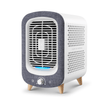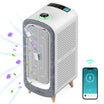Introduction
The smoke from wildfires can be extremely dangerous to your health. It's important to know what you're dealing with and how to protect yourself during a wildfire.
The combination of smoke and ash makes wildfire air pollution worse.
Wildfire smoke is made up of both ash and gases. When a wildfire is put out, some of the smoke that was created by burning vegetation will still remain in the air for several weeks after it has been extinguished.
Wildfire ash can contain harmful substances like arsenic, fluoride, lead and mercury. These substances can cause health problems for people who breathe in large amounts of ash-filled air over time.
A large amount of wildfire ash falling onto crops and grasslands can also be harmful to animals that eat them, like cows or sheep feed on grasses which have been covered with ash from burning trees or brush near their pasturelands
Pollutants from wildfires can travel far, fast.
Wildfire smoke can travel hundreds of miles, and it can travel across state lines. It can even travel across country borders, which means that wildfires in Canada or the United States could send their smoke into your neighborhood. Wildfire smoke can also reach you in other ways. For example, if you live near the coast, wildfire smoke may be transported by wind currents and carried over to Europe or Africa by sea breezes.
Wildfire air pollution has a negative impact on human health
Wildfire air pollution has a negative impact on human health, particularly for those who have preexisting health conditions such as asthma or heart disease. The danger of wildfire smoke is especially dangerous for individuals with chronic disease and pregnant women.
The good news is that the impacts are temporary—the wind and rain will clear away most of the smoke within a few days after a major fire. In addition to staying indoors when possible, you can also protect yourself by:
Keep windows closed at night and use air purifiers if you have them in your home.
Avoid strenuous exercise outdoors during peak hours (midday or evening) when air quality is worst.
Wildfire smoke is made up of a mix of gases and small particles that are released when burned vegetation and other materials react with oxygen in the atmosphere.
Wildfire smoke is made up of a mix of gases and small particles that are released when burned vegetation and other materials react with oxygen in the atmosphere. The gases come from burning trees, shrubs, grasses, and other plants. This smoke can cause health problems because it may contain harmful gases such as CO2 and methane—which can contribute to global warming—as well as nitrogen oxides (NOx) that react with sunlight to form ozone.
The particulates are tiny pieces of ash or soot made up of carbon (black), silica (white), aluminum oxide (red-brown), calcium oxide (grey), titanium dioxide (white) and iron oxide among other things. They are released into the air during combustion reactions between oxygen atoms in plant material with carbon contained within them. These particles are considered most harmful when they get into people's lungs where they can cause respiratory problems like asthma attacks or lung cancer if inhaled over long periods of time
The particulates in wildfire smoke can penetrate deep into the lungs, causing inflammation that leads to health problems like asthma, bronchitis and heart disease.
Wildfire smoke can travel far and fast. The pollutants in wildfire smoke can penetrate deep into the lungs, causing inflammation that leads to health problems like asthma, bronchitis and heart disease. Despite their small size, the tiny particles that make up wildfire smoke are harmful because they contain chemicals known as polyaromatic hydrocarbons (PAHs), which are released when burned vegetation or other materials react with oxygen in the atmosphere. PAHs can cause cancer when people breathe them in for a long period of time.
Smoke from wildfires also contains carbon monoxide, carbon dioxide, nitrogen oxides, and other toxic chemicals that are harmful or fatal to humans if inhaled in large doses.
Smoke from wildfires also contains carbon monoxide, carbon dioxide, nitrogen oxides and other toxic chemicals that are harmful or fatal to humans if inhaled in large doses.
Carbon monoxide is a colorless, odorless gas that is produced when burning wood or other carbon-based fuels. It can cause headaches, nausea and dizziness at low concentrations but it can be fatal at higher levels.
The particles released during a wildfire contain the same chemicals as the ones emitted from a wood-burning stove.
Wood smoke contains carbon monoxide and other toxic chemicals, and unlike car exhaust, it's not good for you. Breathing it in can cause health problems like coughing, wheezing and chest discomfort (especially with long-term exposure). If you're experiencing any of these symptoms while working at or near a wildfire or smoldering forest fire site where there has been significant smoke inhalation, be sure to seek medical attention immediately by calling 911.
We want to make sure you're safe and healthy during these times.
When air pollution levels are high, it's important to take steps to protect yourself and your loved ones. Air purifiers can help remove harmful particles from your home's air and make it safer for you to breathe. Be sure that the air purifier you use has been approved by the Environmental Protection Agency (EPA) or another safety agency.
If you have a pet or small child in your home, be sure they're not exposed to unsafe levels of pollutants when an air purifier is turned on. Some models may emit more pollution than others if they have been poorly designed or manufactured; this is why it's critical that you look at reviews before purchasing one! Consider whether an elderly person would be able to use such a device safely as well—if they've had any kind of health issues recently, this could be dangerous for them too!
Conclusion
If you're concerned about the air quality in your area, you can check it out on this site.











Leave a comment
This site is protected by hCaptcha and the hCaptcha Privacy Policy and Terms of Service apply.